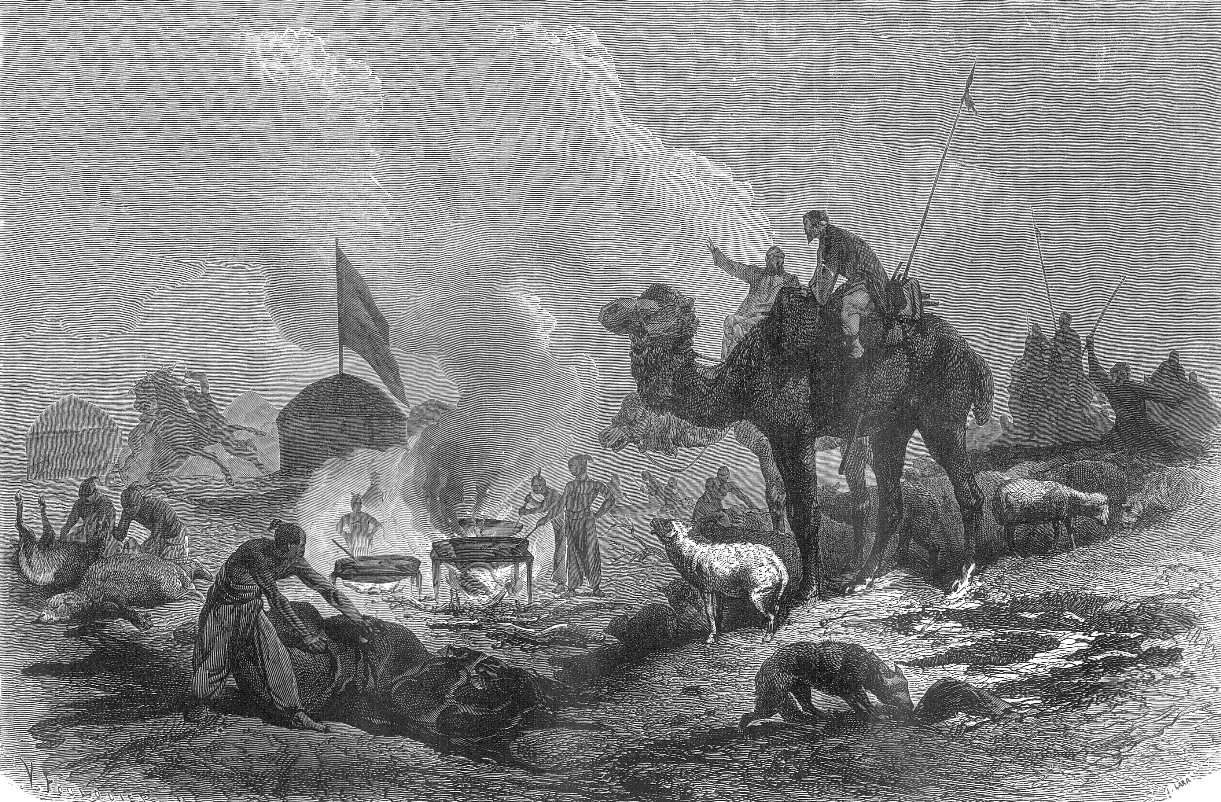Zhailau as a center of funeral rites of ancient Turks and Qazaqs of the 18th–19th centuries
DOI:
https://doi.org/10.69567/3007-0236.2024.2.157.179Keywords:
stone sculptures, as beru, Turks, Qypshaqs, Qazaqs, Qyrgyz, oshaqAbstract
The article comprehensively examines and supports the notion that the Qazaq tradition of conducting funeral ceremonies (ас беру) and the installation of stone statues in the early period were a singular ritual action. It is evident that the places of installation of stone statues from the Turkic period coincide with the places of holding funeral ceremonies among the Qazaqs. These locations within the steppe can be identified as distinct toponyms. As usual, these valleys are still associated with funeral ceremonies and are named in honor of this or that deceased as “hearth of such and such” (for example, "Ormanbet's hearth"/Орманбет ошағы) The “hearth”/ошақ was the place where the “field kitchens” were located during the funeral feast. Domestic animals were slaughtered, cauldrons were placed, and meat was constantly cooked for the guests. In some places in the steppe, remnants of the hearth have been preserved in the form of a hole or a place lined with stone. The article additionally presents the outcomes of field studies conducted in the relevant locales; outlines the customs and ancient rituals associated with the funeral feast; scrutinizes the elements of stone sculptures depicting dishes and utensils, demonstrating their connection to the ancient custom of funeral feasts; and delves into their semantic significance.
References
Abishev, H. 1962. Aspan siri [Mystery sky]. Almaty: Qazaq memlettik sayasy baspasy (in Qazaq).
Ağybai tegı, M. (ed.). 1992. Aqjoltay Agybay batyr. Jezkazgan: Obltipografiya (in Qazaq).
Andreev, I. 1820. Kirgiz-kaysaki Bolshoy, Sredney i Maloy ordy po zapisyam Andreyeva, s dopolneniyami P.K. Frolova i izdatelya [Qyrgyz-qaisaqs of the Great, Middle and Small Horde according to Andreev’s notes, with additions by P.K. Frolov and the publisher]. In: Sibirskiy vestnik, 9–11 (in Russian).
Bronevskiy, S. 1830. Zapiski general-majora Bronevskogo o kirgiz-kajsakah Srednej ordy [Notes of Major General Bronevsky about the Qyrgyz-Qaisaqs of the Middle Horde]. In: Otechestvennyye zapiski [Domestic notes], 43 (124), 119–356 (in Russian).
Castagne, J.-A. 1910. Drevnosti Kirgizskoj stepi i Orenburgskogo kraja [Antiquities of the Qyrgyz steppe and Orenburg region]. In: Trudy Orenburgskoy Uchenoy Arkhivnoy Komissii [Proceedings of the Orenburg Scientific Archival Commission], 22 (in Russian).
Castagne, J.-A. 1911. Nadgrobnaja sooruzhenija kirgizskih stepej [Tombstone structures of the Qyrgyz steppes]. In: Trudy Orenburgskoy Uchenoy Arkhivnoy Komissii [Proceedings of the Orenburg Scientific Archival Commission], 26 (in Russian).
Castagne, J.-A. 2007. Drevnosti Kirgizskoj stepi i Orenburgskogo kraja [Antiquities of the Qyrgyz steppe and Orenburg region]. Second edition. Almaty: Dyke-Press (in Russian).
Chormanov, M. 2000. Qazaqskiye narodnyye obychai [Qazaq folk customs]. Qaragandy: Arko (in Russian).
Dosymbayeva, A. 2006. Zapadnyy Tyurkskiy kaganat. Kulturnoye naslediye Qazaqskikh stepey [Western Turkic Kaganate. Cultural heritage of the Qazaq steppes]. Almaty: Kompleks Publishing (in Russian).
Grach, A. 1961. Drevnetyurkskiye izvayaniya Tuvy [Turkic sculptures of Tuva]. Moscow: Izdatelstvo vostochnoi litetatury (in Russian).
Halid, Kurbangali. 1992. Tauarih hamsa: Bes tarih [Tauarikh hamsa: Five stories]. Trans. B.Totenayev, A.Joldasov. Almaty: Qazaqstan (in Qazaq).
Jurtbay, T. 2024. Qynanbai (Zhabir sultany). URL: https://abaialemi.kz/post/view?id=910 (accessed: 31.01.2024) (in Qazaq).
Kyzlasov, L. 1964. O naznachenii drevnetjurkskih kamennyh izvajanij, izobrazhajushhih ljudej [On the purpose of ancient Turkic stone sculptures depicting people]. In: Sovetskaya arkheologiya [Soviet archeology], 2, 27–39 (in Russian).
Levshin, A. 1832. Opisaniye kirgiz-kazachiikh, ili kirgiz-kaysatskikh ord i stepey [Description of Qirgiz-Cossack or Qirgyz-qaisaq Orda]. Vol. 3. Saint Petersburg: Karl Kray Publisher (in Russian).
Lipkin, S. et al. (trans.). 2004. Manas: Velikiy pokhod. Kyrgyzskiy epos [Manas: The Great March. Qyrgyz epic]. Bishkek: Sham (in Russian).
Margulan, A. 1985. Ejelgi jyr, anyzdar: gylymi-zertteu makalalar [Ancient poems, legends: Research articles]. Almaty: Jazushi (in Qazaq).
Margulan, A. 2007. Ūlytau töñıregındegı tas müsınder [Stone sculptures around Ulytau]. In: Margulan, A. Shygarmalary [Works]. Almaty: Alatau, vol. IV, 221–274 (in Qazaq).
Narody Rossii. Kirgizy. Jetnograficheskie ocherki [Peoples of Russia. Qyrgyz. Ethnographic essays]. 1879. St. Petersburg: Tipografija tovarishhestva «Obshhestvennaja pol'za» (in Russian).
Radlov, V. 1989. Iz Sibiri. Stranitsy dnevnika [From Siberia. Diary pages]. Moscow: Nauka (in Russian).
Rudenko, S. 1953. Kultura naseleniya Gornogo Altaya v skifskoye vremya [Culture of the population of the Altay Mountains in the Scythian period]. Moscow: Leningrad: Izdatelstvo AN SSSR (in Russian).
Rychkov, N. 1772. Dnevnyye zapiski puteshestviya kapitana N.Rychkova v Kirgis-kaysatskoy stepi 1771 godu [Day notes of the voyage of captain N.Rychkov in the Kirgis-Kaisak steppe in 1771). Saint Petersburg: Tipografiya Imperatorskoy Akademii nauk (in Russian).
Sharipov, S. 1982. Baganaly elinin jayi [The situation in the country of Baganaly]. In: Shygarmalar jinagy [Collected Works]. Vol. 2. Almaty: Jazushi (in Qazaq).
Sher, Ya. 1966. Kamennyye izvayaniya Semirechiya [Stone sculptures of Semirechye]. Moscow; Leningrad: Nauka (in Russian).
Shombal-Kukashev, R. 2001. O simvolike starinnogo kazahskogo pominal'nogo rituala «tuje sheshu» [About the symbolism of the ancient Qazaq funeral ritual “tuye sheshu”]. In: Qazaqtyn adet-guriptari men salt-dasturleri: otkendegisi jane bugini [Qazaq customs and traditions: past and present]. Almaty: Gylym, 351–373 (in Russian, Qazaq).
Smagulov, E. 2019. Qazaqtyn as beru dasturi: aleumettik-sayasi retteushilik qyzmeti [Qazaq
commemorative feast (as) social and political function (basis sources of the 18–19 centuries)]. Nur-Sultan: Altyn kitap (in Qazaq).
Venyukov, M. 1868. Puteshestviye po okrainam russkoy Azii i zapiski o nikh [Travel to the outskirts of Russian Asia and notes about them]. Saint Petersburg: Tipografiya Imperatorskoy Akademii nauk (in Russian).
Walikhanov, Sh. 1985. Sledy shamanstva u kirgizov [Traces of shamanism among the Qyrgyz]. In: Sobraniye sochineniy: v pyati tomakh [Collected works in five volumes]. Vol. 5. Alma-Ata: Glavnaya Redakcia Qazaqskoi Sovetskoi Entsiklopedii (in Russian).
Yermolenko, L. 2004. Srednevekovyye kamennyye izvayaniya Qazaqstanskikh stepey [Middle-century stone sculptures of Qazaqstan steppes]. Novosibirsk: Institute Archeology and Ethnography (in Russian).
Zeland, L. 1885. Kirgizy (etnologicheski ocherk) [Qyrgyz (ethnological sketch)]. In: Zapiskiy zapadno-sibirskogo otdela Russkogo Geograficheskogo Obcshestva [Zapiskiy of the West Siberian Department of Russian Geographical Society], 7 (2), 1–78 (in Russian).

Downloads
Published
Issue
Section
License

This work is licensed under a Creative Commons Attribution-NonCommercial 4.0 International License.



